



















To register your child for September 2023, please visit our website at HSD.ca. Parents and caregivers are encouraged to register their children in January for September entry, as this will assist schools in planning and scheduling. Early registration also provides the opportunity to participate in upcoming orientation events in spring.

For those who do not have access to the Internet, please call the school nearest your residence. School staff will assist in completing the first step of the registration process over the phone.
To be eligible for registration, children must be five years of age on or before December 31, 2023. Students are required to attend the school within the catchment area where they reside, which ensures balanced enrollment across the division. Please view catchment maps at www.HSD.ca.
Questions? Please email info@hsd.ca or call 204-326-6471.

Um die Anmeldung zu beginnen, gehen Sie bitte auf die www.HSD.ca Webseite. Die Eltern/ Erziehungsberechtigte sind aufgefordert ihre Kinder so bald wie möglich anzumelden. Die frühe Anmeldung hilft den Schulen in der Vorbereitung für das nächste Schuljahr und bietet Eltern/ Erziehungsberechtigten und Kindern die Möglichkeit an den Willkommens-Veranstaltungen im Frühling teilzunehmen.
Für diejenigen, die keinen Zugang zum Internet haben, möchten wir bitten, die nächstgelegene Schule anzurufen. Um die ersten Schritte der Anmeldung ausführen zu können, wird Ihnen das Schulpersonal telefonisch zur Verfügung stehen.
Für die Anmeldung des 2023-2024 Schuljahres, muss Ihr Kind spätestens bis zum 31. Dezember 2023, fünf Jahre alt geworden sein. Es ist notwendig, daß die Schüler an der Schule ihres Wohnbezirks angemeldet werden, dieses wird sicherstellen, dass die Anmeldungen der Schulen im ganzen Schulbezirk ausgeglichen sind. Wenden Sie sich bitte an die “HSD catchment maps” (HSD Schulbezirkskarte) auf der Webseite.
Bei Fragen wenden Sie sich bitte an info@hsd.ca oder 204-326-6471.



St. Adolphe, Ste. Agathe, New Bothwell, Otterburne, and Tourond. Additional copies are manually distributed to businesses in the aforementioned communities, as well as the town of Landmark. The paper is printed in Canada by Derksen Printers Ltd. Republishing of this paper in whole or in part without prior approval is strictly prohibited.
By Brenda Sawatzky LOCAL JOURNALISM INITIATIVE REPORTER m bsawatzky@nivervillecitizen.com
In 2023, if all goes as planned, Niverville will quite literally double in size. A proposed request to annex nearly 2,600 acres of land from the RM of Hanover now sits before the province’s Municipal Board awaiting approval.

The land transfer initiative is a collaboration between Niverville and Hanover, both of whom recognize the mutual benefits that could be gained by such a move.
For Niverville, procuring the additional land is one of the only ways to secure continued residential, commercial, and industrial growth well into the future.
The eventual development of a business corridor that runs along the two-mile stretch from Niverville to Highway 59 could well provide an economic boon for neighbouring Hanover as well.
“We could say no to this whole project,” says Hanover reeve Jim Funk. “But the province might come along and say, ‘Niverville is growing and they need space. You have no choice but to give it up…’ We’re just trying to work together with Niverville so that we can both benefit out of this deal.”
If the application receives






provincial approval, Funk says a cost-sharing deal will be worked out between the RM and the town in order to bring water and sewer amenities to the commercial corridor.
The 50 parcels of land within the annexation area belong to approximately 45 private landowners. In order for the province to look favourably on Niverville’s request, it’s imperative that the affected landowners understand the ramifications of such a land reallocation.
To make the process as seamless as possible, Niverville’s town council hired Urban Systems.



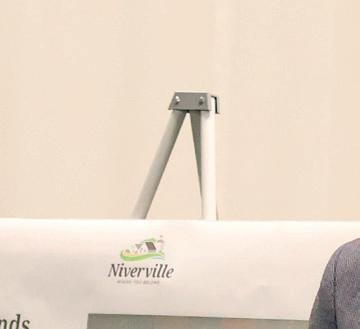



The first task of this team of community planners was to create a sustainable growth strategy for the community in order to help determine how much additional land would be required to maintain the town’s current rate of growth.
Next, Urban Systems engaged the RM of Hanover in the conversation and eventually took it to the local stakeholders for feedback.
On December 7, all of the affected landowners were invited to attend an open house hosted by Jeff Palmer and Aaron Snider




of Urban Systems. According to Palmer, attendance was good.
Naturally, most landowners were curious to know how the proposal would impact them directly. The majority of the land in question is currently zoned for agricultural use.
“I think we can say that this is a long-term vision for planning for the growth of Niverville,” Palmer says. “And in the short- to mediumterm it will have next to no impact on those landowners in terms of their ability to farm.”


When referring to the long-term picture, Palmer says the community’s land needs for the next 50 to 100 years were considered.
For some in attendance at the open house, the term annexation bore some misunderstanding. Palmer indicates that it’s imperative to recognize that the privately owned land is not being expropriated.
“Annexation is when land is transferred from one municipality to another, in this case from Hanover to Niverville,” says Palmer. “Expropriation is where the municipality takes the land for a public purpose with compensation, but that’s not what we’re talking about here at all.”
(continued from page 3)

When land is annexed, little changes for the affected landowners. They continue to maintain full ownership and land use remains the same as before.
Should any of these landowners decide to sell to a developer in the future, an entirely new process must take place if the land is to be redesignated from agricultural use. That process requires provincial approval for rezoning and a public hearing to allow for community feedback.
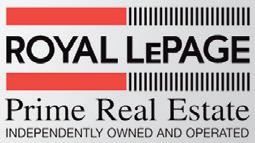
“It would be extremely unlikely that the municipality would initiate that process,” Palmer says. “It’s usually done as a result of a willing buyer and a willing seller wanting to change the use of the land.”
The primary short-term impact to the landowners will be the transfer of property taxes to Niverville as opposed to Hanover. To help ease any additional tax burden, Niverville council has worked out a plan whereby landowners would go from no change to their tax rates in the first year to being fully transitioned to Niverville’s rates by year five.
With increased property taxes also comes increased amenities, though. Property owners within the annexation zone can expect to eventually benefit from town services such as road maintenance, garbage and recycling collection, and sewer and water hook-ups.



Much research goes into creating a sustainable growth strategy for a community. With Niverville’s rapid growth in past years, it’s especially important to take a close look at Statistics Canada data and
other resources to help predict reasonable patterns for the future.










“The actual growth of Niverville has exceeded every [comparable] estimate that I’ve seen so far,” Palmer says.


According to data analyzed by Urban Systems, Niverville has experienced an astounding 343 percent increase in population over the past 25 years. At this rate of growth, the community will have exhausted its current supply of developable land within the next 15 to 20 years.

In another 25 years, it is predicted that Niverville will have a population of almost 30,000 if growth is moderate, or closer to 40,000 if growth continues to climb steeply.
But Palmer says that good municipal planning means far more than just preparing for residential growth.
“We’re trying to diversify the land uses in Niverville and encourage more commercial and industrial development in order to offer jobs within the community,” says Palmer. “There’s a lot of people that live in Niverville that go elsewhere to work. It’s important that there be jobs in the community that people live in.”
Along with the landowner open house, Urban Systems is also hosting two public open houses which anyone may attend. The first took place on December 8 and the second was held at the Heritage Centre on December 13.


Residents were also very much encouraged to fill out an online land annexation survey by December 22.
“It’s the easiest way for us to keep people informed and to reflect their comments to the province,” Palmer says. Once public engagement
efforts are complete, Urban Systems has said that they will submit a summary of public feedback to the province.
Then the wait begins.
At the provincial level, the process is rarely black and white, Palmer says. Oftentimes the Municipal Board makes revision requests and these negotiations tend to slow things down.
According to Luc Lahaie, CAO for the RM of Hanover, a similar annexation request was made in recent years by the City of Steinbach, which was looking to procure land from Hanover in the area just north of the city.

The request was for 7,200 acres, nearly three times as much as Niverville is asking for. The Municipal Board approved the request but only for about half the amount of land.
Generally speaking, Lahaie says the province looks favourably on annexations that support urban growth.
“Whenever an urban community wants to grow, the province will always support the urban area if they have a plan showing the reasons why they need that extra land,” says Lahaie.

This is true even for agriculturally zoned land, he adds, if it’s near an urban centre where services already exist nearby.
What is being discouraged is the subdivision and rezoning of agricultural land in rural areas where it will unnecessarily fragment the farmland.

If and when Niverville’s annexation application is approved by the province, town council will set to work updating their development plan and zoning bylaws in order to take the new land parcel into consideration.

Seven residents of Ritchot and Niverville were honoured to receive the Queen Elizabeth II Platinum Jubilee Award this month.

Honorees include local mayors Chris Ewen and Myron Dyck, Ritchot councillor Janine Boulanger, as well as a selection of community champions including Shaun Crew of Ste. Agathe and Shirley Hoult, Libby Hanna, and Gordon Daman of Niverville.
“I am pleased to announce that these members of our constituency are to be recipients of the Queen’s Platinum Jubilee Award,” says Ron Schuler, MLA for Springfield-Ritchot. “The Queen’s Platinum Jubilee Medals are just one way in which we can give back to the people who have made these communities a better place to live.”
The Platinum Jubilee medals were created in celebration of Queen Elizabeth II’s seventieth year since her accession to the throne, which began on February 6, 2022—and ended, of course,


with her death in September of this year.


One thousand recipients across Manitoba have been bestowed with the honour of receiving a medal this year at ceremonies held throughout the province.
Nominees for these awards are recognized for the contributions they’ve made to Manitoba, with a strong focus being placed on community mindedness, service, and reconciliation.
Schuler says that Mayor Ewen seemed a clear candidate due to his commitment to always finding ways to better the lives of Ritchot residents.
“He is dedicated to his community and works hard to see the best results for them,” says Schuler.
Similarly, Mayor Dyck was lauded for the part he’s played in Niverville’s rapid and progressive growth.
“Under his leadership, Niverville has expanded greatly, becoming the fastest growing municipality in Manitoba and the fifth fastest growing municipality in Canada,” Schuler says.
As councillor of Ritchot for the past five years and president of






the Grande Pointe Homeowner’s Association, Boulanger was recognized for her tireless volunteerism and advocacy for the people she represents.
“She is always active in the community and looking for different ways in which she can help the people of Ritchot,” says Schuler.
Shaun Crew received special mention as a pillar in the Manitoba business community.

“He has gained entrepreneurial success and used that success to help benefit the RM of Ritchot,” Schuler says of the well-known entrepreneur. “He has dedicated his time to volunteering and serving his community through various boards. He is the true definition of a Manitoban success story.”
Hoult, Hanna, and Daman were all recognized for their longterm dedication as volunteers in their community.
Hoult has poured years into serving on the Niverville Communities in Bloom board, ensuring that the community is an attractive place to live. She’s been a member of the local Chamber of Commerce and sat on the board of the Growing Minds daycare.

For Hanna, decades of service have gone into local sports initiatives such as Clippers Hockey and ringette clubs. She’s been chairperson of the Niverville Credit Union board and spent time on the Providence University College board of governors.
Finally, Daman will be remembered by many for his roles as town councillor and eventually mayor from 1998 to 2006. He is also no stranger to community championing, evidenced by his work in helping establish the community’s unique aging-in-place model at the Niverville Heritage Centre.
“Wherever she can, Shirley has been an active force in making the community of Niverville a better place,” Schuler says. “[Libby] was one of the driving forces behind the Niverville Community Resource and Recreation Centre committee. This deep involvement in the community is why she was nominated… I am especially thankful for Gordon’s help with the wastewater treatment facility… He more than deserves the Queen’s Platinum Jubilee Medal.”






 By Brenda Sawatzky
LOCAL JOURNALISM INITIATIVE REPORTER
By Brenda Sawatzky
LOCAL JOURNALISM INITIATIVE REPORTER
m bsawatzky@nivervillecitizen.com






Niverville’s council plans to add six new surveillance cameras to the approximate 20 that already exist around the town’s outdoor public spaces.








As well, they’ll look to install an audio system at the town office to augment the surveillance system.



Extra town personnel will be added to the list of those authorized to view video footage and provide information to the RCMP.
The new cameras will likely be destined for some of the smaller parks scattered throughout the town.
The surveillance camera initiative began a number of years ago on Councillor Chris Wiebe’s recommendation.
But council’s plan was to create more than just a deterrent. Guided by RCMP consultations, council determined that an investment in high-definition cameras would serve a greater purpose.
Since that time, Wiebe says that they’ve been able to provide police with video footage showing youth stealing signs, details of car accidents, and tracked a vehicle used by thieves to commit robbery.
On one occasion, they even caught on tape a pedestrian being hit by a car.
In many circumstances, council says that the footage has been invaluable to the RCMP to determine fault or locate perpetrators.
Other times, the footage serves to help the police build a file on suspects.

Each camera comes at an average cost to the town of $2,500.

















































A three-year process is officially underway which, by 2025, should give residents of Ste. Agathe a much higher level of protection from future floods.
Thanks in part to recommendations made in the Manitoba 2011 Flood Task Force Report, work has begun to help ready Red River Valley communities to withstand floodwaters to up to one-in-200-year levels.
Residents of Ste. Agathe were invited to two public information sessions held at the Culture and Community Centre on December 13. This event kicked off round one of public engagement.
Working together on the project, the event hosted representatives from Manitoba Transportation and Infrastructure (MTI), KGS Group, and Scatliff, Miller and Murray—all experts in the field of landscape engineering and urban development.

“We’re all Manitobans,” said Bruno Arpin of KGS Group. “We’ve been dealing with flooding forever. Over the past 60 years, the province has worked to make communities more resilient, and we’ve been successful in doing that, but there’s always room for improvement. And that’s why this project is so important. There’s more that can be done.”
The primary goal of the initial public meeting was to inform and then allow residents an opportunity to ask questions and relay any concerns they may have.

In the coming weeks, site investigations and environmental assessments will be performed along the ten kilometres of the Ste. Agathe dike. Findings will be presented at a second public meeting in January. Further community feedback to the findings will assist engineers in drawing up design alternatives.
A third and final public meeting will take place in February, when preliminary designs will be unveiled. Following more feedback, a report will be submitted to the province for consideration.
“We need to make sure that
with anything we do… we don’t have a detrimental impact,” said Arpin. “We need to present options that are viable, that will work for the community. The work is going to have a footprint. Most things do. My goal is to eliminate [negative] impacts where possible.”
To help fund this massive project, consultants hope to access federal grants while they’re still available through the Investing in Canada Infrastructure Program (ICIP).
Jared Baldwin is the MTI project manager on the Ste. Agathe Dike Raise project. He’s also a prior resident of St. Adolphe and understands the challenges of living in a flood zone.
“In 1950, we had a pretty catastrophic widespread flood,” Baldwin told those gathered. “That prompted a lot of flood protection projects throughout the province. One of the most prominent projects that came out of that was the Floodway, but a lot of flood protection projects were done throughout the Red River Valley as well. Various towns received flood protection in the form of ring dikes. Some of them received full circumference ring dikes, some did not. Ste. Agathe was in the latter category, where some dikes were constructed and some existing infrastructure was leveraged to provide some of that protection.”
The original Ste. Agathe
dike was constructed in phases throughout the 1960s and 70s. For the most part, it provided adequate protection for the community over the next quarter-century.
In spring of 1997, the community was hit hard when unprecedented floodwaters breached the rail portion of the dike on the west side, inundating the community.
Shortly thereafter, the dike was raised on all sides, bringing it up to 1997 levels plus two feet.
The only exceptions were the highway access points, also called closures, and an approximate one-kilometre section of land extending along the riverbank on the east end of town.
“The engineers at the time said that the riverbank stability was of concern, so it was never built there,” Baldwin said. “The idea was that, as the floodwaters increased in elevation, a [temporary] dike would be built. The water, as it’s rising, provides a little bit of a weight against the riverbank so it’s a little more stable and can accommodate the dike. But then when the water’s receding, the opposite happens. It becomes unstable, so the need is to remove that dike as quickly as possible.”
Since that time, the construction of temporary earth berms and sandbagging has been necessary on a near annual basis.
Over the years, these temporary flood protection measures have been responsible for the destruction of some trees and walking paths along the riverbank.
In order to meet the one-in-200year flood protection level, some parts of the ring dike will require more attention than others.
“The closures require the most amount of fill when there’s a flood,” Arpin said. “Closure number one, at Highway 75 north, requires the most amount of fill at 4.6 meters.”
Arpin adds that there’s a lot to consider when undertaking such a project. Locating and working around buried infrastructure is one thing. Another is the stabilization of riverbanks to prevent erosion while maintaining the river’s flow and characteristics.
Drainage, of course, will also be of utmost importance.
Once everything is documented, the practicality, feasibility, and affordability of the dike raising project should become clearer.


Joel Lemoine, councillor for Ste. Agathe, says he’s pleased with the turnout of 40 to 50 residents at the December 13 sessions.
For the most part, he says, people took the time to voice their concerns.
Some of the concerns he’s heard from his constituents prior to the meeting focused on how individual property owners would be affected by a higher dike. Some worried about losing their river view. Others shared concern over backyard privacy lost to hikers and off-road vehicles that might use the dike summit as a trail.
As well, many cite drainage issues, since the dike has the same capacity to keep rainwater in as it does to keep floodwaters out.
All in all, though, Lemoine feels the broad representation of professionals at the public meetings demonstrated a willingness to collaborate with the community on this project.
“It shows us that the province and the engineers and professional agencies are [making themselves] available to talk and actually showing that something is being done,” Lemoine says. “I think it’s just reassuring for everybody.”
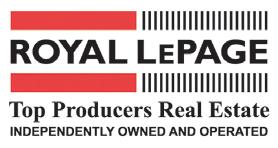
 m bsawatzky@nivervillecitizen.com
m bsawatzky@nivervillecitizen.com


Council hopes to complete installation of two new crosswalks along Fifth Avenue in 2023. The areas in question include the intersections of Hampton Drive North and Hampton Drive South.
Since Fifth Avenue falls under the province’s jurisdiction, an application has to be submitted to Manitoba Transportation and Infrastructure (MTI) before any changes can be made.
“We’ve heard from residents and have had our engineers and staff look at these intersections,” says Mayor Myron Dyck.
“We see that there is a lot of traffic of pedestrians—children, young people, all ages—trying to get into [Hespeler Park] and also trying to get across to be able to get to various schools.”
Submitting an application to MTI for crosswalks will set a process in motion, says CAO Eric King.
MTI then responds by sending out an inspector to perform pedestrian traffic counts at both intersections.
King adds that there may also be an option of shared funding between the town and MTI. If, for example, MTI is willing to install the paint and signage, council may choose to go one step further by adding safety lights at one or both crosswalks.
The crosswalk safety lights currently in use at the intersection of Mulberry Avenue and Main Street will be coming down once traffic lights go up in 2023. At this point, King says that council will consider moving them to one of the two locations on Fifth Avenue South.
Yes. No one should ever have to go hungry.
No. There is too great a stigma attached to it. I would find another way.























Have a more nuanced opinion? Leave us a comment online.

In 2022, more Manitobans than ever are reaching out to local food banks for help to get through these tough inflationary times. So far, the donations are meeting demand.


Helping Hands coordinator Larissa Sandulak says the Niverville food bank began receiving a big increase in food hamper requests long before this year’s Christmas season.
“Since the summer, we’ve had a 20 percent increase in families needing hampers,” says Sandulak. “Every week we have multiple new families getting in touch with us. This significantly increases the amount of food we require to keep up with the need.”
Sandulak is thankful for the various food drives and collection bins around town that have worked to keep the pantry stocked.
In early December, she was hopeful that the month’s collection efforts would be enough to fill the many


Christmas hamper requests that were coming in.
“We will need the community’s continued support,” said Sandulak before the holidays, although the need extends well beyond Christmas. “Residents can leave donations in our bin at Bigway or make a tax-receipted financial donation on our website if they’d like to help us meet the
increased needs.”
Helping Hands was seeking groups, businesses, or individuals who would be willing to sponsor a family in need during the Christmas season.



Suzanne Tetreault is one of three coordinators who manage the Île-des-Chênes
food bank out of the rectory next to the IDC Parish. Due to a lack of space for large-scale food and toy storage, the food bank relies on sponsorships of families at Christmas as well.
In Ritchot, local companies have stepped up this year, reaching out to the food bank to offer sponsorship of multiple families at a time.
“We’ve given out the names of nine families, mostly those with kids,” said Tetreault in early December. “So the [company staff] will be making their Christmas hampers and buying cute gifts for the kids.”
This generosity meant the food bank could use items coming in from the local food drives to keep their shelves full, as Tetreault doesn’t see the need for food assistance going down anytime soon.
Tetreault and her team also witnessed a surge in hamper requests this past summer. They have been consistently filling 24 biweekly hampers in comparison to the average 17 hampers needed in the first half of 2022.
Harvest Manitoba, an organization previously known as


























I think the French language isn’t as prevaillant as it used to be. Niverville has an influx of all nationalities already. When do we include Mideastern, Asian or any one of the African languages. I understand that Canada is a bilingual nation, but that law was passed when Canada was founded. I know several people who went to a French immersion school in the city and they absolutely abhorred it. They genuinely wish they had been enrolled in an English speaking school.
Learning Canadian French is not only unimportant in North America but also unimportant in the world. Its only important to our current French dominated federal government. Made in Ottawa nonsense. That must be changed. Canada and especially Western Canada is multicultural and, beyond English, people's own mother tongue ought be be encouraged (at no extra cost to the state). There are many second languages used in western Canada and the world that are much more important to know than some version of Canadian French. Chinese, Hindi, Ukrainian and various native languages come to mind. Beyond learning their own mother tongue, let our children learn real skills and subjects of importance to becoming more functional and contributing working citizens in Canada.
As Niverville continues to grow, this may be needed. But, I don't think there is enough interest at this point.
Winnipeg Harvest, has also witnessed a surge in requests for food aid like they’d never seen before.
“Since last year around this time, the demand for food at Harvest has increased by 41 percent,” says Harvest’s Christa Campbell. “And the number of people with jobs who are accessing the food banks has increased by 50 percent. There is no precedent in our 38-year history for an increase of this size.”
Currently, Harvest Manitoba supplies food supports for around 90,000 Manitobans, almost half of whom are children. That equates to 12 million pounds of food annually.




To pull this off, says Campbell, it requires an ongoing army of faithful and generous supporters. To date, the support being received is still adequate in meeting demand.
Recently, the CBC held their annual Make the Season Kind radiothon in support of Harvest. The project has raised $364,000.
Harvest Manitoba also provides food to many smaller food banks around the province when their own resources run low.

On December 19, the province announced plans to provide aid to the most vulnerable families affected by the soaring costs of food.
A $3 million grant has been designated for Harvest Manitoba, the primary distributor of food donations to food banks across Manitoba.
Former Niverville resident Donna Swarzynski recalls with poignancy the memory of the first time she needed the help of a food bank. It was 2016. Swarzynski
and her young daughter were enjoying the feeling of new condo ownership in Niverville and Donna’s career as a car sales consultant was going well.
One day, Swarzynski says, it all came apart when the feelings of deep sadness she’d been experiencing rose to the surface. Her doctor recommended short-term sick leave from her job, but the mental battle persisted and soon she found herself jobless.


Trying to subsist on health insurance payouts alone wasn’t enough and she had nowhere to turn for help. Her parents had died years prior.
She said it was a church acquaintance who suggested that Swarzynski take advantage of the services of Helping Hands. This was a first for her. She’d placed donations in the bin at the local grocery store before.
Never had she considered she might someday need it herself.
“I remember pulling up to the [food bank] and feeling hopeless and so alone,” says Swarzynski. “I sat in my car for a few minutes before I had the courage to walk inside and ask for help. I remember walking up to the big brown steel door and starting to cry. I couldn’t believe I was in this position of needing help. I had always worked, since I was 14 years old... As I started to walk down the stairs, with my head held down and with tears in my eyes, I looked up to see about six ladies smiling and welcoming me to Helping Hands. One of the ladies immediately came up to me and put her arms around me and comforted me. She was like an angel in disguise, giving me hope in what I felt was a hopeless situation.”
Swarzynski’s challenges






didn’t end that night. She eventually found herself in a shelter in Steinbach until affordable housing was found.
Today, she has become a valuable volunteer at Steinbach Community Outreach, an organization whose mandate is to assist people experiencing poverty and lack of housing by providing food, shelter, clothing, and friendship.
One of her greatest joys now is being that angel in disguise for someone who comes to the Outreach for help.


“I feel like I’m able to empathize with people more,” Swarzynski says. “When I tell them that I used to be homeless, people’s eyes just get big and they can’t believe that [someone like me] was once in their shoes.”
It’s especially hard for parents, she adds, when they feel the pressure of needing to provide not just for themselves but the little lives that depend on them. Not to mention the extra dose of humility it takes to tell the children where their food and clothing comes from.
“I think any time of year is a hard time for people to ask for help, whether it’s Christmastime or not,” Swarzynski says. “It’s easy for people to naturally want to help other people, I think, but to ask for help is very difficult.”

Swarzynski is glad to tell her story. She’s a survivor and wants to help break through the shame so others can become survivors too.





































Helping Hands: www.nivervillehelpinghands.org IDC Food Bank: Suzanne Tetreault, 204-878-3189 Harvest Manitoba: www.harvestmanitoba.ca

It’s been two months since Ritchot’s council first announced a new daycare pilot project. In 2023, the brand-new 6,000-square-foot facility will provide an additional childcare 74 spots. Sixteen of these spots are designated for infants and the remaining 58 for preschool children.
“Having more daycare spaces in Ritchot will give the opportunity to families to potentially reduce their commute times,” says Ritchot mayor Chris Ewen.
While the new spots are a good start, though, it likely won’t put a huge dent in the growing demand.
Lana Redmond, director of St. Adolphe Childcare Inc., says their current waitlist is between two to three years in length. What does this mean in terms of the number of children waiting to get in? She says it’s somewhere around 300.
The St. Adolphe Daycare’s longest list is for kids needing before- and after-school care, says Redmond. This is because these kids don’t age out of the program until they turn 12.
“If they had a spot [in childcare], and they took their child out, then they’ve lost that spot and a lot of them didn’t want to do that,” says Redmond.


Lack of childcare spots isn’t the only thing plaguing the system. Redmond says that daycares across the province are also struggling to find enough qualified staff.
She’s hopeful that the federal government’s implementation of a wage grid supplement for early learning educators will encourage more people to get into the field.

In this series, The Citizen profiles locals who strive to make our little corner of Manitoba a better place. Each month, we feature a person, family, or business that helps brighten the world in some way. If you have someone in mind for a future month, please nominate them: jlavin@nivervillecitizen.com
By Jennifer Lavin m jlavin@nivervillecitizen.comSusan Shaver has noticed that a lot of people seem to be struggling of late. Whether it’s a result of financial issues, depression, job insecurity, or holiday stress, she couldn’t help but observe a marked downturn in people’s spirits.

“People are down in the dumps, being mean to each other, lashing out, and just being miserable in day-to-day life,” says Shaver. “It just seemed everyone was just so unhappy, in what should be a happy time.”
While driving home from work one day recently—she calls it “windshield time”—she suddenly came up with an idea to get people out to do something fun. Something that wouldn’t require a huge commitment. Something that might bring a little smile to their day.
Her idea was to launch a community treasure hunt—but she knew she would have to most fast to get the event organized quickly enough to make it happen during the busy holiday season.
With time being of the essence, she stopped at various businesses around Niverville that very day and asked if they be interested in donating prizes. After receiving an unexpectedly great response, later that day she posted her idea to Facebook.
From there, she was granted even more donations.
Shaver set to work assembling gift packages, getting so excited about the project that she decided to put together some children’s gift
packages as well.
“I went to the local dollar store and purchased small items and candy and such to make kids packs,” she says. “And I caught up with Jonathan [Schmitke] at Bigway, who graciously donated Terry’s Christmas oranges for every gift package I made.”

The way the treasure hunt works is that everyday she posts a clue to Facebook, often in the form of a riddle. People then have to decipher the clue and head out into town to find the day’s prize.
The hunt has been a great success so far and many Niverville residents have chimed in with kudos for Shaver.

Stephan and Vanessa Geissler were able to find and claim the prize one day, and they also have the pleasure of knowing Shaver personally. The Geisslers point out how the holiday treasure hunt has helped get people excited to engage with their community.
The Geisslers’ four-year-old daughter Heidi even got involved and found the kid’s prize one day.
“I drove with Mommy and Daddy to look for presents and we found them,” says Heidi. “I like that!”
“The scavenger hunt idea is fantastic, particularly in these cold

winter months where people naturally grow crankier and have less patience,” says Stephan. “But far beyond the scavenger hunt, Susan is someone who has built her life around serving others, from her lengthy career as a paramedic and saving countless individuals to her current position as a paramedic instructor, leading the next guard as our protectors. She truly cares about the safety and health of all people. Niverville is lucky to have someone as thoughtful, caring, and devoted to the community and its citizens as Susan.”
Michelle Driedger agrees that Shaver is an amazing community member in general. Recently, Dreidger’s vehicle got stuck in a town parking lot and she posted a request for help online. She says that Shaver immediately came by and helped her out.
“As far as the scavenger hunt goes, I thought it was truly amazing of her to not only organize this, but get out there and hide gifts and post clues,” Driedger says. “That’s all time she’s spending on her own and offering others free of charge. I had an absolute blast seeing her clue and racing out of my door to find the prize. It put such a smile on my face to play! I really want Susan to know that
she is very much appreciated for doing things like this, especially now when everyone can use a little happiness and joy! She’s a really incredible person.”
Tyler Tardiff is a newcomer to Niverville. He and his family have been pleased to participate in the hunt and use the opportunity to explore their new town.
“It’s a real fun way to get into the Christmas spirit,” says Tardiff, who also sees how impressive it is that she was able to garner so much support from local businesses.
In fact, Shaver herself is just as impressed with that detail.
“A huge shoutout goes to everyone who gave me stuff,” Shaver says with a laugh. “Because who just gives stuff to some random woman chattering about her great idea?”
So why has Shaver done all this?
“We have been through a lot in the past few years, and it’s wearing on everyone,” she says. “It seems that moods are poor, relationships are crumbling, there’s less money to spare, and people just seem to be angry at everyone. I just wanted to do something to brighten a day! My motto in life is ‘Be kind.’ It’s my email signature, usually written somewhere on my clothing, and just something I try to live by. And this just was something I felt I needed to do.”
After 20 years as a paramedic, Shaver moved to Niverville in 2015 with her son Ethan and says that they very quickly fell in love with the community. She also has an older son who has blessed her with three grandsons.
Shaver is currently an educator and clinical instructor for the Paramedicine Program at Red River College Polytech.
She also volunteers with the local fire department and offers first aid services for Nighthawks home games.
If there is a need to be met, chances are Susan Shaver and her “Be kind” motto are already on their way.
It’s no fluke that the Niverville Nighthawks are firmly in the playoff race in their inaugural season. Not only have the players on the club been heavily scouted over the past year and a half, but they’ve also been slotted in to play specific roles on the team.









Although the teammates hail from all over North America, perhaps the area with the highest concentration of players is northern Minnesota and North Dakota, which is in close proximity to Niverville and the rest of southeastern Manitoba.
Carson Reed comes from Warroad, while Gavin Gunderson grew up in nearby Roseau.
These two towns, about 20 miles apart on the Minnesota side of the international border, are famously hockey rivals.
Going a shade further south, you’ll find Brendan Bottem’s hometown of Thief River Falls. Ty Kennett comes from Red Lake Falls, also in


Minnesota,
All five players play critical roles for the first-year Nighthawks—and within the ranks of the team, they’ve become known as the Nighthawks’ own “Minnesota Mafia.”
One of the team’s scouts, Scott Oliver, operates out of the United States and has been instrumental in bringing these players into the fold.
Oliver has been coaching high school hockey in Minnesota for years, so he has a good handle on all the different programs on that side of the border and some of the key players in the region.
“He’s been an invaluable resource in bridging that gap, and helping on the recruiting side,” says Nighthawks assistant general manager Mike McAulay. “We had some limitations when building our roster out. It’s not the NHL, and there wasn’t an expansion draft, so we were limited as the 12 other MJHL teams had a 50-player protected list. So 600 local players were already accounted for. It made

us unlock different players outside the province.”
It’s almost comical, in a way, but these five American players actually have a shorter commute home to and from Niverville than someone who lives in Brandon.

“It’s really nice to jump in the car on a day off and only be a few hours from home,” adds McAulay.
“For their families to be able to get off work on a Friday and be here for a game Friday night is great too.”
McAulay can speak at length about these Minnesota acquisitions and the tremendous value they bring to the team.
He says that they all have the skills necessary to compete in the North American Hockey League (NAHL), one of the top junior leagues in the U.S, and then some.
“They really looked at Niverville being a first-year team and thought they could come in and play a key role right off the bat, which would help with their development,” he says. “They all have college hockey on their minds, and that’s their ultimate goal. So I think they looked
at coming up and playing some meaningful minutes with us, and really kind of jump at starting their overall development.”
Early in the season, the Nighthawks made a move and acquired Braden Panzer of Grand Forks.
The 19-year-old had spent time earlier this year with the Minot Minotauros of the NAHL.

“I watched him play at Grand Forks Central as a senior, and I really liked him then,” adds McAulay. “He was a USHL draft pick too, with the Fargo Force, so we knew there was a lot of skill and a lot of compete there. Panzer was looking for more of a role and to be more of a go-to guy to play in different situations, and we had that for him. So we’re really fortunate to be able to broker that deal with Minot to bring him in.”
The so-called Minnesota Mafia is working out pretty well so far for the Nighthawks, as the team currently sit in an MJHL playoff spot more than halway into the 2022–23 season.






 By Ty Dilello m tdilello@nivervillecitizen.com
By Ty Dilello m tdilello@nivervillecitizen.com

December was a challenging month for the Niverville Nighthawks, with a schedule that saw them go three weeks without a home game due to a road trip followed by the Christmas break.
Through the highs and lows, the team pulled through with a 4–3–1 record on the month, including their second momentous win against arguably their fiercest rival, the league-leading Steinbach Pistons.

With 26 games yet to play in their inaugural season, the Nighthawks find themselves in a strong position to make the playoffs. They currently sit in fourth place in the MJHL’s East Division, nine points ahead of the fifth-place Winnipeg Blues.

(WAYWAYSEECAPPO WOLVERINES, HOME)

The Nighthawks started the month by pulling out an important 3–2 win at the CRRC in their first tilt against
the Waywayseecappo Wolverines this season.
After a scoreless first period, the Nighthawks opened the scoring five minutes into the second frame when Brendan Bottom potted home his thirteenth goal of the season. The Wolverines tied it up later in the period, and then the teams traded goals once more to end the period tied at 2–2 apiece as Josh Paulhus scored for Niverville.
Braden Panzer was the game’s hero midway through the third period. His goal held as the game-winner.
Chris Fines was excellent in the Nighthawks’ goal, making 31 saves for the win.
“I found Waywayseecappo a fast and tough team to play against, as they work hard every shift,” said defenceman Evan Bortis. “I think we need to be more disciplined and bare down in our own zone every shift tomorrow night [when we face them again]. The boys played very well to take the win at home tonight, but tomorrow will be a battle, and we
will need our whole team to bring their best game of the season.”
As the team reached the midway point of the season, Bortis, with 22 points in 25 games, said he was quite pleased with the team’s performance so far, noting that every campaign has its ups and downs.
“We have a solid group of guys that would go to war for each other every night,” he said. “Our record does not show how good of a team we have here in Niverville. We are finding the consistency from each guy every night now, and when everybody is going, we are a top team in this league. It feels good to be in a playoff spot right now, but it’s only partway through the season. We are looking to climb in the standings and punch our playoff spot earlier rather than later. We have lots of work to do till playoffs start, and all the boys are ready to go to work to do so!”

(WAYWAYSEECAPPO WOLVERINES, AWAY)
The Nighthawks gave it a strong fight
but just couldn’t pull out the win on Saturday night as they fell on the road during their rematch with the Wolverines.
Nonetheless, it was a strong start for Niverville as they jumped out to a 2–0 lead after goals from Ty Kennett and Paulhus.
Waywayseecappo fought back in a big way throughout the second half of the game, scoring four times, including one empty-netter to defeat Niverville 4–2.
Ethan Kadatz worked hard in the Nighthawks goal, stopping 29 shots.
“We did some things right to get ourselves up in the game,” said head coach Kelvin Cech. “Ethan was great in the net early and gave us a chance. And then we just made a couple of mistakes, and they’re a skilled team that turns the puck north as quick as any team we’ve seen so far. So we shot ourselves in the foot a bit with some mistakes, and they were able to bury their chances.”
Cech was proud of his team’s effort in the home-and-away series
with Waywayseecappo, one of the top teams in the MJHL this season.
“We competed well these two games,” said Cech. “We would have liked four points, but two is better than none. So I think we earned some respect from them. We can work on some things from these games and try to get better.”
Overall, Cech was elated about where the team was at the halfway point of the season. He noted many positives they could build on for the second half of the campaign.
“Individually each player is coming along and is developing well,” he added. “The guys have 25 games of experience now in the MJHL, which is very valuable. It’s crazy that we’re at the halfway point, but time flies when you’re having fun! We’re just trying to learn lessons in managing the game and the puck now.”

DECEMBER 9
(STEINBACH PISTONS, HOME)
Call them the giant killers! For the second time, the Nighthawks

knocked off the first-place Steinbach Pistons, this time with a massive 5–2 win at the CRRC.
The Pistons had only lost twice so far this season, with half of those losses coming at Niverville’s hands.
An added bonus to the win is that it came on volunteer appreciation night, which meant an even fuller barn than usual at the CRRC.
“Anytime you can get points in this league is special,” said Cech. “For us to get a win on a night that’s already special, as we’re honouring all of the volunteers that make this all possible, is quite something.”
Bortis got things started in a big way just a minute into the game with an early goal. However, it was the Pistons who got the next one with a short-handed tally late in the first frame.
Niverville started the second period off with a bang when Ben Whitford scored just 42 seconds into the period. Isaac Rentmeester scored a little later to give the Nighthawks a 3–1 lead heading to the third period.
Steinbach got one back midway through the period to cut the deficit, but from there the Nighthawks played excellent shutdown hockey and didn’t provide the Pistons with any significant scoring opportunities.
Paulhus scored for Niverville with three minutes left, and then Braden Panzer iced the contest with an empty net goal a minute later to give the Nighthawks the hard-fought 5–2 victory.
Fines was strong in goal for the Nighthawks, stopping 21 shots.
“We had four good practice days coming into this game,” said Cech. “We had a game plan, and the guys executed it. We defended well and limited their shots for the majority of the game. That was the key, just playing smart defensively. We were able to bury our chances. And we’re fortunate to get the two points.”
Cech eagerly looked forward to the quick turnaround, providing them with the chance to face Steinbach again the very next night, this time on enemy turf.
“Josh Paulhus has taken the group under his wing and addressed the team after this game that we’re not done,” Cech said. “We’re going to give everything we have into the next game, and as a coach you love to hear that. So we’re excited to see what they bring to the table tomorrow!”
It was a spirited effort from the Nighthawks, but in the end they fell to the Steinbach Pistons 5–3 in the rematch.
Both teams persevered through a tight and scoreless first period before play opened up.
Carter Spirig scored the first goal two minutes into the second period, and Bortis made it 2–0 just a few

minutes later. The Pistons recovered with two goals later in the period to tie the game.
Spirig scored his second goal early in the third period to give the Nighthawks a lead once again, as it started to look like Niverville was on the verge of knocking off the top-ranked Steinbach club for the second straight night.
However, Steinbach was able to pull it together by scoring twice late in the final frame and adding an empty netter to win the game 5–3.
“It’s a little bittersweet, because we were four minutes away from overtime, and we just made a mistake that cost us the game,” said Cech. “So we’ll learn from that and move on. It was a strong effort. But man, it just sucks to lose.”
Chris Fines was spectacular in the Nighthawks’ goal, making 48 saves on 52 shots.
“Fines was busy tonight,” Cech said. “We didn’t have the same gas in the tank as the previous night, and that showed. They came out really strong, but Fines stopped some quality chances all night and gave us a chance to win. He was fantastic.”
With this game in the bag, the Nighthawks had some time off before returning for a three-game road trip before Christmas during which they would play three times in four nights.
“At this point, our systems are pretty set, and everyone on the team knows how we want to play and what makes us successful,” said Cech. “The guys have really bought into it, so for the next week we want to exaggerate those good things that we do and bring that into these next stretch of games before Christmas.”
The Niverville Nighthawks fell in overtime to the Winnipeg Blues 3–2 on the evening of December 17.
It was a bit of a slow start for the Nighthawks, as they’d had more than a week off since the two-night series with Steinbach.
Ultimate, they just didn’t quite have the legs needed to compete with the Blues, and after the first period Winnipeg led 2–1, with Hayden Wheddon scoring for the Nighthawks.
The Nighthawks found their legs throughout the second period, however, and were finally rewarded when Braden Panzer scored with two minutes left in the period to knot the game at 2–2.
After a scoreless third period, the Nighthawks were off to a rare threeon-three overtime session, the great majority of their games this season
having ended in regulation.
Sadly, the Nighthawks couldn’t pull the game out. Winnipeg scored two minutes into overtime to win 3–2.
Ethan Kadatz stopped 30 shots in goal for the Nighthawks on the evening.
“The two points would have been nice, but it’s always important to get a point in this league,” said Cech. “Performance-wise, it wasn’t good enough, particularly earlier in the game. We had a long week off to prepare... and the better team won tonight. You have to be on your game every night, and you can never take your foot off the gas.”
Cech also noted that his club hasn’t had the pleasure of playing overtime too many times this season, and perhaps some extra practice at that aspect of the game is needed.
“We do some defensive zone three-on-three stuff to work on in regard to coverage in our own zone,” he said. “But it’s probably on me that we don’t practice overtime a ton, as it doesn’t happen to us often. The coach has to make better decisions there I guess.”
to us lately. We had a good first period, as it was really back and forth. A good start for sure, but they were able to get the jump on us in the second period, and we struggled the rest of the game.”
Although the Nighthawks had found themselves on a bit of a midmonth losing skid, Cech wanted to emphasize positivity and trust the process.
“The message is that we’re frustrated, and things haven’t gone our way, but that happens to every hockey team on planet earth and we need to just remember why we play this game,” he said. “We have one more game left before Christmas, so we just need to have a good day at practice tomorrow and focus on the process and remember we’re in a fortunate position, and it’s supposed to be fun. So we’ll have fun at practice and hopefully bring the good vibes to the rink for our game on Tuesday.”

The Nighthawks snapped their three-game losing streak on Tuesday night as they defeated the Winnipeg Blues 3–2 in overtime. With the win, the Nighthawks headed into the Christmas break on a high note.
After giving up an early goal to the Blues, the Nighthawks fought back late in the first period with a goal from Spirig on the power play.
chances offensively to boot.”
Before signing off for the holidays, though, Coach Cech faced one last all-important question: what did he want for Christmas from his Nighthawks?
“I just want a refreshed squad coming back. They’re gonna go home and fill up their hearts and their bellies a little bit, but hopefully not too much! The team can all relax and come back refreshed and ready for a huge second half to the season.”
The Nighthawks came back from their Christmas break ready to ring in the new year with a victory at home over the Winnipeg Freeze. With the New Year’s Eve win, the team improved to 17–13–1 on the season.
“We were recharged and had three really good days of practice and got to work on some specific stuff that definitely showed up in our game,” said Cech. “We came out strong and put up a lot of shots and were fortunate enough to get a couple by their goalie.”
It was a game in which the Nighthawks outshot the Freeze by a 55–23 margin. And yet shots alone don’t win games—those shots have to go in—and the scoreboard remained close right to the end.
After a scoreless first period, Spirig got the Nighthawks on the board early in the second period. The Freeze replied with a goal of their own shortly afterwards, but then Rentmeester found the back of the net again for Niverville.
(WINKLER FLYERS, AWAY)
It was an especially forgettable encounter on Sunday evening as the Nighthawks fell 5–2 to the Winkler Flyers—a tough opponent in a tough rink.
To the Nighthawks’ credit, they came out of the gates with somewhat more intensity than the previous night’s encounter with the Blues.
Trading chances with Winkler throughout the first period, the Flyers finally opened the scoring with 15 seconds remaining.
Things started to fall apart late in the second period for Niverville as the Flyers found the back of the net three times in the last five minutes.
Once Winkler scored again early in the third period, the Nighthawks rallied with goals from Wheddon and Ethan Kelly, but it was too little too late.
Fines stopped 32 shots in goal for the Nighthawks in the losing effort.
“Winkler checked hard, as we didn’t have a lot of time and space out there,” said Cech. “They created a lot of chances just by being relentless. And a couple of bad bounces, which seems to be happening a lot
The two teams played a tight game the rest of the way, with each team scoring just one more goal.
Merik Boles scored for Niverville to tie the game at 2–2 early in the third period.
Heading to overtime for the second time in three games, the Nighthawks earned a better outcome this time around, as Gavin Gunderson scored the game-winner.
“Getting them back is great, and you can’t script it any better with an overtime win,” said Cech. “Having Gavin Gunderson back in the line-up and providing us with the winner was awesome. But most importantly for the team, there’s been some ups and downs the first half of the season, so to go into the break with a big win like that against a tough opponent feels wonderful.”
Cech was most pleased that his team played much better with a full 60-minute effort than the last two games.
“We rolled four lines, and everyone contributed,” he said. “We also did a much better job with our habits in the defensive zone. Things like stops and starts, tying up sticks in front, and stuff like that. So we did a good job of that and had lots of
From there, Niverville sniper Paulhus took the game over in the third period, posting a hat trick on the night. When the dust settled, the Nighthawks won the game 5–3, much to the delight of the strong crowd at the CRRC.
“We were at a shot-a-minute pace for the first half of the game, but no goals, until Ethan Kelly got a tipped shot through, and their goalie couldn’t see it, which gave us a confidence booster,” said Cech. “After that, it was an up-and-down game, but we were able to pull out the win.”
The player of the game was undoubtedly Paulhus, who now has 17 goals and 20 assists for 37 points in 31 games with 50 penalty minutes.
“I can’t say enough positive things about Josh Paulhus,” Cech added. “We made the deal to get him in the summer. He just plays the right way every single night as he’s in the fight for us always and is very annoying to play against. So we’re happy he’s on our team. He played his one hundred fiftieth junior game the other night, and he said he wouldn’t want to play anywhere else than Niverville with us, so it was a big moment for the fellas. For him to then pot home three goals tonight and wear the fireman’s helmet after the game
special.”
was very
“The guys have 25 games of experience now in the MJHL, which is very valuable. It’s crazy that we’re at the halfway point, but time flies when you’re having fun!”
Kelvin Cech | Head Coach












































































































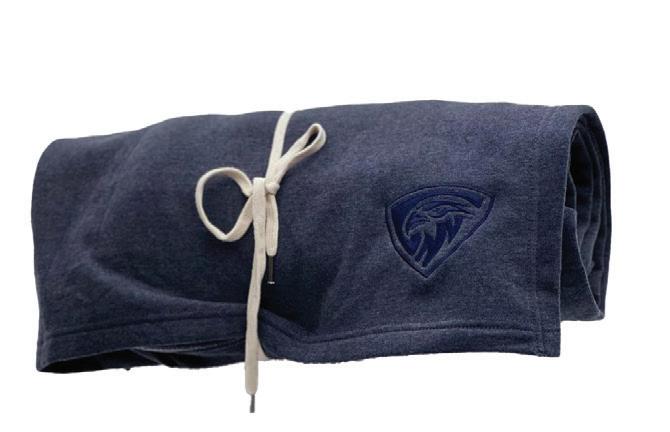


 By Brenda Sawatzky LOCAL JOURNALISM INITIATIVE REPORTER m bsawatzky@nivervillecitizen.com
By Brenda Sawatzky LOCAL JOURNALISM INITIATIVE REPORTER m bsawatzky@nivervillecitizen.com
Every winter, as sure as the snow flies, we can also expect the certainty of complaints about windrows.
Without question, it can be infuriating to dig your way out of the driveway only to find a barricade of heavily packed white stuff blocking your access when you return home.
Neither is it unfair, really, to assume that if your tax money covers the cost of street-clearing, it should likewise take care of the cost of cleaning up the windrows left behind by town equipment.
In 2019, The Citizen published an article to address all these concerns. It’s entitled “The Windrow Controversy: Who Should Take Responsibility?”
At the time, Mayor Myron Dyck provided feedback as to why the town rarely assumes responsibility for clearing windrows.
First and foremost, there’s the cost of equipment and employees that would be required to provide this additional service in a timely manner.

Council could simply raise taxes and make it happen, Dyck said, but then everyone pays, including those who are quite willing to do it themselves.
Conversely, those who are willing to pay for this service could hire a local contractor, boosting the local economy as they do.
“If people were to hire businesses that provide snow-clearing services, the cost to the resident could very well be the same [as paying more in taxes],” Dyck told The Citizen in 2019. “However, money in a business owner’s pocket [funnels] back into the community. Employees are hired, equipment is purchased, the money buys groceries, building supplies, and restaurant visits right
here in our own community. Thus, the economic spinoff is greater by hiring a business owner than simply paying more taxes.”

Today, Mayor Dyck has more to say to the argument that paying taxes should automatically qualify a homeowner for windrow removal services.
In order to fully appreciate the tax-dollar-to-town-service ratio, Dyck says that homeowners need to recognize that a huge proportion of property tax income is collected from local businesses who pay tax at a much higher rate than homeowners do.
He says that statistically, across most communities, a resident’s taxes pay for only about 50 percent of the services they benefit from.
“Really, you should only be


getting half of what you are actually getting because that’s all your tax dollars are paying for,” Dyck says. “The rest is offset by your business community, which is why we try and drive our business [growth]. That’s why we need to support local business, because that’s the handin-hand arrangement that makes a community work.”
Liability is a whole other concern for council when it comes to taking responsibility for windrow cleanup.
If damage to a driveway is caused by heavy equipment, who pays for those repairs? If it’s the town, this means that everyone’s taxes will have to go up again.
Dyck says, for now, that the town’s focus will be on getting traffic moving as quickly as possible, because council recognizes that Niverville
is a commuter community. With the single grader and two front-end loaders currently owned by the town, the first round of cleanup to make streets passable can still be completed within a matter of a day or two.
Other communities vary in terms of the street cleanup services they offer.
Many, like Niverville and Ritchot, leave windrow responsibility to the residents. Others, like Steinbach, have an ambiguous windrow policy that states, “If windrow heights warrant, driveway windrows will be cleared.”


The town of Altona operates snowblowers that follow the grader to clean up windrows. The city of Winkler operates a grader with a driveway wing. Any snow ridge left behind by the wing is the
responsibility of the resident.
In Winnipeg, crews clear away driveway windrows if they reach eight inches in height or higher, but the city’s policy states that this service can be delayed until adequate resources are available.
Since residential streets in Winnipeg take third priority, it can take quite some time for street cleaners to begin cleanup in these areas. From that point, the policy allows for up to five days for cleanup of residential areas and windrow cleanup happens some time after that.
Perhaps one of the most extreme examples of a laidback municipal approach to snow-clearing, though, comes from the city of Regina.
According to their policy, residents are not only responsible for driveway windrow cleanup but also for the sidewalk that borders their property, and it must be cleared within 24 hours of a snow event.
Residents of Regina must also apply sand to the sidewalk if needed, with sand they must pick up from one of the city’s distribution locations.
As for street-clearing, the city of Regina’s website further states, “Residential streets are only plowed after substantial snowfall (15 cm of snow from a single event) and when weather and time permits.”














For old schoolers, 15 centimeters of snow equates to almost six inches. And those six inches of snow need to fall all at once for the city to clear a residential street. But if ten inches of snow fell over the course of two snow events that happened within days of each other, residents could be left to fend for themselves.
So in the end, every city, town, and municipality takes their own approach to snow-clearing and windrow removal. All in all, residents have to evaluate which services are important and which are not when they choose where to put down roots.
 By Evan Braun m editor@nivervillecitizen.com
By Evan Braun m editor@nivervillecitizen.com

It’s been just better than two years since the Niverville Open Health medical clinic transitioned from being a privately owned to a publicly owned entity, and so far the situation is looking optimistic.
In a matter of 32 months, the clinic will have grown from two doctors to ten, following the early 2023 return of one who’s currently on maternity leave.
As well, two nurse practitioners have joined the team and the reception staff now numbers six.
Perhaps one of the most important factors behind these successful staffing efforts is Open Health’s business manager, Kristen Fyfe, who was hired by the Town of Niverville in February 2020 as the new public model of clinic governance was being rolled out.

Fyfe’s full-time role is to oversee the day-to-day operation of the clinic, to act as a liaison between the clinic and town council, and to provide an administrative presence with Niverville Healthcare Services Inc. (NHCSI), a not-for-profit oversight board.



NHCSI is also new as of 2020. Other members of that board include town councillor Nathan Dueck, CAO Eric King, Dr. Lila Boroditsky, Dr. Ashley Britton, longtime local physician Dr. Chris Burnett, and Scott Wallace of the Niverville Chamber of Commerce.



“We have provided over 1,000 [new] patients… with a family doctor this year alone,” Fyfe says with pride. “We have served thousands of patients on a same-day basis who needed care, who either did not have a family provider, or who could not
get in promptly with their family provider. The demand for appointments is very high, so this is something we look at all the time and hope to continue to expand these services as we are able.”
She says that the additional physicians have also made it possible for the clinic to expand its hours this year to include Saturday morning same-day appointments.
“We know there is a large demand for same-day care and we are doing our best to fill in the gaps as we can,” Fyfe says. “Our team is our greatest success, though. We have a hard-working team of providers, nurses, allied health professionals, and staff.”

The successes already achieved by Open Health are impressive on their
own merit. But when they’re viewed through the lens of all the challenges that have materialized in the last couple of years, it’s more remarkable still.

When the clinic transitioned away from the privately operated enterprise belonging to Drs. Chris and Mairi Burnett, it was in a weakened state.
In the fall of 2019, Dr. Mairi was diagnosed with multiple myeloma, an incurable form of cancer impacting the plasma cells in her bone marrow.
Between cancer symptoms and treatments that left her weak and at risk, Dr. Mairi was faced with having to take an indefinite period of time off work.
The clinic’s only other full-time physician at the time, Dr. Chris, was attempting to juggle two full patient loads, care for his wife, and keep

the clinic financially afloat on one income.


To make matters worse, the contract of the single physician assistant they employed at the time hadn’t been renewed.



Dr. Chris was stretched too thin. The future of the clinic was in imminent danger and the Burnetts’ dream of continuing to practice in their home community looked decidedly bleak.
In January 2020, Dr. Chris reached out to town council and Niverville Heritage Holdings board members to see if some sort of solution could be found.
Recognizing the value that the clinic and the Burnetts brought to the community, town council made the quick decision to engage the services of Kathy McPhail, former CEO of Southern Health-Sante Sud (SHSS).

McPhail was commissioned to put her 45 years of practical experience to use by performing a study on the sustainability of the clinic and exploring options under which it could be supported.
By mid-February, her report came back with a clear message: while there would be significant challenges, the clinic was viable in the long-term, given proper management and oversight.
Weeks later, the Burnetts became contracted physicians, and together with Fyfe and the newly organized NHCSI they forged ahead.
Two weeks in, the COVID-19 pandemic arrived. The timing could not have been worse.

Mayor Myron Dyck explains that the number of patients seeking care dropped off significantly as people became afraid to spend any length of time in public spaces frequented by sick individuals.
“Clinic visits are what is billed to the province as per the established tariff rates,” Dyck says of the healthcare model. “While video visits used to not be tariffed, the province changed that [during COVID]. However, those are at a lesser rate than in-person visits. So, in short, COVID has stunted the growth and clinic profitability. Hopefully next year, with additional doctors and no shutdowns, the clinic will see a profit, allowing council to begin to reinvest that profit back into healthcare in our community.”
The pandemic was also partly to blame for an extreme shortage of physicians in Manitoba, and elsewhere across the country, as time went on.
“Doctor recruitment is complex, and when talking with many other clinics we have learned that we all
face similar challenges when it comes to recruitment, especially in a rural setting,” says Fyfe. “Statistics from Doctors Manitoba can be found online. I believe Manitoba has the lowest number of doctors per capita in Canada.”
In preparation for what council and NHCSI had known would be a particularly difficult first year, the 2020 budget was created with the expectation that the floundering clinic would need to receive a provisional grant from the town of $148,000 in order for it to get back on its feet.
If the situation proceeded as hoped, the grant would allow for a break-even year.
Instead, only $120,000 of that grant turned out to be needed. The result was an end-of-year surplus of almost $50,000.
In 2021, the amount of the town’s provisional grant dropped to half as much, clocking in at just $65,000.
That year closed with a $19,000 surplus.
Year three hasn’t yet been audited, but CAO Eric King anticipates that the required grant will be cut almost in half again, landing somewhere between $35,000 and $40,000.
By the end of 2023, King feels fairly confident that the clinic will be fully self-sustaining.
The goal, eventually, is to reach a place where the clinic is fully staffed, has longer hours of operation, and offers even more services such as a full lab and diagnostics.
Even before that goal is met, though, Councillor Nathan Dueck envisions a clinic that will experience a growing profit margin that can be reinvested right back into the facility.
“This way, the money that’s made at the clinic stays in the community, so that in the future we can start adding diagnostics and other things if there’s adequate evidence of a return on the investment,” Dueck says.
In the meantime, Kings says that the seed money provided to Open Health to date is technically a repayable grant, with the expectation that the town can request repayment when the clinic finds itself in a profitable position down the road.
Revenue generated by Open Health comes from a variety of sources. First and foremost is the doctor-generated revenue. The ten doctors working out of Open Health work on a fee-for-service model.
“What this means is when a patient visit is billed to Manitoba
Health, the doctor is paid and the clinic retains a percentage of those billings,” Fyfe says.
To help rural clinics acquire and maintain physicians, the province offers doctors an additional five percent rural billing bonus if they are willing to work outside of Winnipeg’s city limits.
In order to further encourage doctor recruitment, the contract between Open Health and its doctors amounts to a competitive 80/20 split, with the clinic keeping 20 percent to cover overhead costs such as administrative salaries, rent paid to the Heritage Centre for use of the building, the cost of medical supplies, etc.
Another source of clinic revenue comes from SHSS, which provides some financial investment towards reception staff whom they share with Open Health.
“This collaborative model allows our clinic to have a cen-
consistently to remain profitable,” says Fyfe. “So it is important to note that even with 10 to 11 doctors, that may not equate to six full-time positions, and we are actively working on this goal.”
At present, and with its current staffing levels, Open Health is operating at 4.8 full-time equivalent positions.
While six full-time equivalent doctors is all that’s needed to balance the books, growing patient demand in the region means that there’s potential for even more doctors to successfully practice out of Open Health.
At some point, space in the facility could become an issue. Therefore, NHCSI has made it a goal to expand clinic hours for now. Running split-shifts into the evenings and weekends maximizes the use of the clinic space and provides increased accessibility for all patients.
Fyfe also anticipates a time in
heavily focus on doctor retention. “Doctors Manitoba released data noting that, in Manitoba as a whole, 43 percent of doctors planned to retire, leave the province, or reduce their practice hours in the next three years,” says Fyfe. “We want our providers to have successful and long careers with an emphasis on work-life balance.”
Councillor Dueck says that one of the best ways to attract doctors is to be a clinic that’s bursting with client potential, which this region is. As well, providing a clinic that’s as well-rounded and outfitted as Open Health should prove to be a boon.
“What we’re realizing is that doctors are happy working in rural Manitoba as long as the tools that they need are provided to them,” Dueck says.
Another appeal of working at Open Health, says Dueck, is the positive working environment with an equitable pay structure.
And when the clinic finally expands to provide diagnostic services, Dueck says this will give physicians just one more reason to come—and to stay.
This may mean further town investment down the road, though.
Fyfe | Open Health business managertralized reception area to direct patients and allow all of the providers, nurses, and allied health staff to work in collaboration in a team environment,” says Fyfe.
Like Open Health, SHSS rents a portion of the clinic space from the Heritage Centre so that they can provide a range of additional clinical staff to complement the office’s services. These include nurse practitioners, primary health and mental health workers, a chronic disease team, public health staff, and child and youth workers.
Since taking time off to manage her cancer, Dr. Mairi has returned to the clinic on a part-time basis. The other nine doctors on staff are a mix, some working full-time and others working part-time.
Some of the part-time physicians working from Niverville also work in Winnipeg at personal care homes or other privately run clinics.
Fyfe says that at the time of the clinic’s restructuring in 2020, a five-year plan was created to help the team focus on their physician end goal.
“The clinic requires six full-time equivalent doctors
the not-too-distant future when the clinic’s services will expand to include a full range of diagnostic services.
“This is something the board discusses on an ongoing basis because we see this as a big need for the community and surrounding areas,” Fyfe says. “There is no set plan currently about specific diagnostics coming to the clinic yet, but we have been looking at the need for EKG, ultrasound, and X-ray.”
Fyfe says that NHCSI is employing a number of strategies to promote Open Health to new physicians.
For starters, they reach out to local universities on an ongoing basis to garner the interest of graduating doctors.
“Many recruitment events went virtual in the last couple of years, making those types of recruitment connections more difficult,” Fyfe says. “We are now seeing the resurgence of in-person events, which we hope to attend in the future in order to make those connections.”
And while the acquisition of physicians is important, Fyfe says that NHCSI’s emphasis will more
“I’m not against investing more money from the community into healthcare if necessary, as long as there’s a method of payback to it,” Dueck says. “I take a look at other communities around the area that are potentially putting in $100,000 to $200,000 per year to just trying to retain two doctors. We’re not in that situation. We have doctors.”
For Fyfe, looking back at the challenging experiences of the past two and a half years is just as important as looking into the future.
“Not enough can be said for what the Burnetts have done over the years, building up the clinic, and the foresight they had to save it from closing,” Fyfe reflects. “Had they not approached the town to present this idea, the clinic would have closed. At the time of restructuring, there was a goal of a four- to five-year turnaround to break-even/profitability and we are right on target for that, with this being possible even a year earlier than expected.”
Until Open Health is better equipped to meet client demand in terms of physicians, Fyfe says residents can register with Family Doctor Finder either by phone or online. The program is designed to connect patients and healthcare providers when and where availability opens up. Family Doctor Finder: https://www.gov. mb.ca/health/familydoctorfinder

e peace of King Jesus is not merely the lack of war. In a certain sense, a graveyard is peaceful. An Empire that grinds down its people into slavery is also peaceful in a certain sense. ere is no conict because any sign of con ict is wholly and quickly suppressed. at is not the peace of which the Scriptures speak.
e peace of Christ closely connects to his justice. It is because he is a just king that we can have peace. e Christian is safe from those who would destroy that peace.
And yet we have a problem: Our Lord is just, but we are not. Our Lord is pure righteousness, but we are full of evil. at is why King Jesus had to die. His death is the punishment my destructive nature deserves. at is why we call our king the saving king. He has come to save.
e peace of Christ often begins with the shattering of false peace, the peace we make with the lies of demons in our hearts and this world. It starts with a declaration of freedom, freedom from the lies, the greed, the anger, and the lust that can control our lives. It is a freedom we have through his death on the cross. But our Lord also rose from the dead. So that, in him, in submission to him, we can have the peace of knowing that we have a Lord who will do what is right.

“There is no set plan currently about specific diagnostics coming to the clinic yet, but we have been looking at the need for EKG, ultrasound, and X-ray ”
Kristen
Niverville’s town council recently released highlights from their 2023 budget planning sessions, held in early December.

This year’s brainstorming session involved two days and a total of 20 hours in roundtable discussions held in the Town of Niverville’s municipal board room.
“This is a plan; this isn’t a promise,” Dyck says of Budget 2023. “This is what council views as the direction they would like to go. But should there be unplanned expenses or unforeseen opportunities, plans can change.”
Some of the proposed highlights for the coming year include the hoped-for acquisition of a new water tanker to assist Fire and Emergency Services.
Council will also undertake to modernize and make accessibility improvements to the lobby and washrooms at the Centennial Arena.
In terms of outdoor infrastructure, a section of Fourth Avenue South will undergo a complete overhaul of the street, sidewalk, sewer, and drainage. Town CAO Eric King describes this street as one of the worst roads in the community, with a long history of inadequate drainage.
Council also plans to apply to the province to install two new crosswalks along Fifth Avenue South.
One would be situated at Hampton Drive North near the Niverville Middle School.



The latter would provide a safer pedestrian crossing at the intersection of Hampton
Drive South and Hespeler Park Drive.
The town will also continue to assist with ongoing improvements to some of the community’s parks, including Opa’s Park, Station Park, and the off-leash dog park.
Additionally, they have committed to increased funding for tree-planting and maintenance.

With the anticipation of a new development soon beginning along Highway 311 west between Krahn and Wallace Roads, council plans to complete the design phase for intersections and commercial access routes in this area.
Public open house events

“Council talked about it,” says Dyck. “It’s about a million-dollar touch, so the reason we may not be doing other things in 2023 is because council has made the decision that they just want to see it paid for and move on, as opposed to a four-year borrow and public hearings to [approve] the borrow. We’re just going to [pay] it from general revenues.”
Dyck says that council has worked hard on bringing this important public safety service to the community in the past couple of years.
“The value is intangible, because without the Town of Niverville making some con-

















hybrid model.”

From council’s longer-term plans arises a goal to find additional space for the Public Works and Emergency Services departments, which currently share a single facility on Bronstone Drive. The fast growth of these two departments is a result of equally rapid residential growth throughout the community.
“Council recognizes that we have to deal with this, so how do we separate those two [in terms] of who goes where and what is needed?” Dyck asks. “That will likely mean a new site for somebody and, depending on annexation, where land is available.”
Finally, council is preparing to make a dedicated effort to provide a public library program and additional daycare space in the coming years.
But first, the mayor says, debt incurred from the CRRC build will need to be paid in full.
will be announced for this development area shortly.
Another new reality is the impending opening of Niverville’s previously announced RCMP office. At this stage, Mayor Dyck says this project will likely be completed around this time next year, as it comes with about an 11-month build.
Council is in agreement that the town should complete a full payout of the costs of the RCMP office in 2023, even if it comes at the risk of putting some other projects on the backburner for now.

cessions, [the RCMP office] wouldn’t be here,” says Dyck.
He points out that a number of years ago, when people were asking about a greater police presence here, the RCMP still felt that Niverville was being adequately serviced by the St. Pierre detachment.
“We said to them, ‘If we provide the space, would you be willing to come?’” Dyck says. “And they said they would provide us with members, which gives residents greater police presence. So we kind of made it a Niverville
“Council recognizes the need for both a public library and additional daycare,” says Dyck. “We’ve recognized that this is the direction we want to go. But COVID-19 definitely slowed the donation drive [for the CRRC]. Yet bills still come due, so we’ve got about five years left. Which is better than 25 years left.”
Dyck adds that the acquisition of a major donor willing to purchase naming rights for the new arena is still a very real possibility. Such an occurrence could significantly reduce council’s timeline in paying off the loan.
A more detailed budget report along with financial impacts will be released by The Citizen as soon as it becomes available.
“Council recognizes the need for both a public library and additional daycare. We’ve recognized that this is the direction we want to go.”
Myron Dyck | Mayor of Niverville













No one likes to be sick. Colds, flus, injuries, and other seasonal illnesses are a physical and mental drag.

When we’re under the weather, getting through the day is a psychological challenge. All we want to do is rest and recover. We eat chicken soup, watch The Price Is Right , and go to sleep hoping we’ll feel better in the morning.
And when we do wake up feeling better, it’s more than just physical. The mental load of being sick has been lifted. We can go about our regular life free from the interference our previous illness brought to our lives.
For some people, though, waking up the next day doesn’t mean feeling better; it means more of the same— the same symptoms, the same pain, and the same psychological struggle.
For many people who live with a chronic illness, this is their reality.
There are a myriad of conditions that qualify as chronic illnesses. There are autoimmune disorders such as lupus or Graves’ disease, progressive neurological disorders such as ALS, inherited conditions like cystic fibrosis, and countless others.
These disorders have diverse symptoms and affect us in unique ways, but they all have something in common: they are permanent.
In most cases these conditions have no cure. And while their symptoms can be managed, they cannot be completely eliminated. In many

cases, the symptoms will go from more to less severe and back again over an indeterminate period of time—sometimes days, sometimes weeks, sometimes hours.













When symptoms are in a mild phase, individuals may be able to function more or less “normally.” They may be able to work, go out with friends, and get through the day like everyone else.
Outwardly, at least.






But when symptoms do flare up, sometimes as a result of trying to function “like everyone else,” they can be debilitating.

Individuals with chronic illnesses may suddenly drop plans with friends, miss important appointments, or be unable to maintain a regular job.
This can be perceived as laziness, inconsistency, or selfishness, and these perceptions can be harmful.
Thankfully, there is much more awareness among the general public about the existence of chronic illnesses and how they impact people’s lives. Most people are aware of at least one person in their lives who has one.
What fewer people are aware of, though, are the mental health challenges associated with living with a chronic illness—and these challenges can be just as debilitating as the physical symptoms.
Here are just a few of the most common mental health symptoms.
Depression. According to recent

research, more than one-third of individuals with a chronic illness will also receive a depression diagnosis.

This is a significantly higher prevalence than what is seen in the general population.





Depression can cause chronic symptoms to become more debilitating and can make it more difficult to work or maintain relationships.
Anxiety. The uncertainty of not knowing when your symptoms will flare up, and the guilt of “letting people down,” can lead to ongoing anxiety.
People with chronic illnesses are more than twice as likely to be diagnosed with anxiety disorders, which can cause their condition to worsen.
Brain fog. Especially in disorders with an element of chronic pain, brain fog (characterized by a difficulty with problem-solving, a lack of mental clarity, confusion, short-term memory loss, and a general “fuzziness” in thinking) can be present too.
The mental load of being in constant low-level—or high-level—pain can overwhelm our brains and prevent us from thinking clearly.
Brain fog often results in difficulty communicating, fulfilling our work or relational obligations, and can lead to worsening symptoms as well as an increased risk of additional symptoms of depression.
As you can see, while chronic illnesses already make it difficult to live up to one’s obligations, the accompanying mental health symptoms

can make it much worse, affecting employment, relationships, even the rest of our physical health.


These mental health symptoms can be exacerbated by other life factors. Poverty, for instance, can greatly increase the mental health impacts of chronic illness.
Research shows that people with lower socioeconomic status typically experience greater impacts on their finances and quality of life. This is certainly because they have fewer resources to support themselves and their families during times when they are unable to work. For people with chronic illnesses, this can result in a cycle of worsening symptoms, worsening depression and mental health, and worsening finances.












Family members of those with chronic illnesses aren’t immune from the mental health impacts.
Research for decades has indicated that people who live with family members with chronic illness, especially those in caretaker roles, have their own high rates of depression and other mental health issues.



A myriad of resources exist to provide help. General mental health supports, as well as specific resources through non-profits and government programs, have been being built for generations. While more supports are still needed, at least care pathways are in place.

For everyone else, what can we do to support our friends, family members, and fellow citizens who
are living with a chronic illness?

First, be understanding of their condition, and believe them when they tell you about their limitations. One of the worst things we can do is to tell them that they “look so good” or “don’t seem sick.” This can increase their own frustration over their unpredictable symptoms.
Second, avoid minimizing or downplaying their symptoms, even if you’re trying to help. Telling them “It could be worse” or “You’ll feel better soon” is both untrue and can feed the mental health symptoms they’re struggling with.
Instead, try expressing that you believe them, acknowledging their efforts, and confirming that you are there for them if and when they need support—or even when they’re ready to spend time together.
Finally, ask if and how you can support them. It can be harmful to assume that others need your help as an able-bodied person. This is often referred to ableism. But showing understanding and letting people know that you’re there for them if needed can be a positive way to provide help. Adjusting your expectations based on what you’re told, and providing the help that’s asked for, allows you to be a tangible support for the person you care about.
Chronic illnesses rarely go away, and they’re rarely cured.
But by walking with each other in kindness and understanding, we can ensure that loneliness is not a factor.
Niverville resident Melissa Burns has developed her love of video games into a challenging and rewarding hobby that takes her all over the world. The phenomenon is called esports.
But what are esports?
“Esports are a form of competition involving multiplayer video games, but unlike games such as Mario Kart, they need to be balanced and won based on skill, technical ability, and strategy without being impacted by luck or chance,” says Burns. “Players can compete in casual scrims or leagues and tournaments, and the best of the best will play professional leagues that parallel those of traditional sports.”
Burns says these players train the same way traditional athletes would, with regimented physical conditioning, nutrition plans tailored to their specific needs, and hours of dedicated practice.
“One thing unique to esports is that fans can often interact with the pros via Twitch streams, and occasionally find themselves in a match with them online,” she says.
Esports is a multibillion-dollar industry that continues to grow. Major events like the League of Legends World Cup now draw in over five million views online in addition to sold-out arena crowds.
Canada has five major league teams with additional farm teams playing in development leagues.
“They are beginning to be featured on sports channels such as ESPN,” says Burns. “The production side is just as developed with shoutcasters, analysts, and interviewers who specialize in their fields.”
Burns describes herself as a “gamer” and has been playing video games her whole life.
“I started as a PC gamer right from childhood and spent countless hours playing console games at my friends’ houses after school,” says Burns.



As a young adult, she spent
several years touring North America doing musical theatre and played League of Legends with her now husband, Chris Burns, as part of their long-distance relationship.
It was Chris who first introduced her to the concept of coaching esports after he started a team at St. Boniface Diocesan in 2012.
She was settling into a teaching career herself after retiring from musical theatre and had a job at Archwood School in Winnipeg where she decided to start an esports team for middle school students.
From there, the program grew quickly and Burns started to take on a leading role in Manitoba.
In 2016, she started Middle Years Esport Manitoba as well as the Manitoba High School Esports Association. Eventually, the two programs combined to create the Manitoba School Esports Association (MSEA).
“We came together to provide a stronger, more unified voice for esports in Manitoba schools and actively work to provide support, professional development, curriculum, advocacy, and research within the field of scholastic esports,” says Burns, who currently serves as chair of the MSEA. “There was a trend towards for-profit American-based organizations hard-selling Canadian schools on their programs during the pandemic, and we wanted to provide a pedagogically sound alternative that was for Manitoba students, by Manitoba teachers.”
In January 2020, prior to the amalgamation of the two smaller groups, Burns had started laying the groundwork to launch the national network for multiplayer competitive video games that would become Esport Canada.
She’d been working on research for a chapter she was writing for an academic textbook on esports research and its integration into education. This required a significant amount of networking to connect educators from across the country.

“This network of educators quickly expanded, allowing us to host competitions for schools across the country that were then streamed and shoutcasted by Canadian universities and colleges. Again, it was our response to pressure coming from American for-profit organizations that were encroaching on the Canadian education system, as our effort to keep esports in schools focused on supporting the student holistically through skill development, career exposure, social/ emotional development, and player well-being, both on and offline.”
This work gained the attention of several colleges and universities across the country and their gamers, who had played exclusively through U.S. collegiate esports leagues since Canada didn’t have one.
This past summer, Burns and fellow educators were able to sign an agreement with a number of founding postsecondary institutions across the country and form Esports Canada, the official home of Canadian varsity gaming.
Aside from organizing non-competitive matches, the organization aims to help students develop within an educational environment.
Shortly after its formation, the Ontario Department of Hospitality and Tourism, as well as another esports industry stakeholder, approached Esports Canada to expand further by adding a competitive division.
This caused the organization to quickly rebrand, as changing the nature of the matches was a move that extended beyond the scope of their education-based program.


“We are now a federally registered not-for-profit governing body for esports in Canada and a National Federation Member of the International Esports Federation (IESF),” Burns explains. “Our mission is to amplify local gaming communities through federal advocacy, international representation, and sanctioned national competition and events that allow all Canadians to engage and excel in esports, while our vision is to see the Canadian Esports Ecosystem thrive by fostering a community built on respect, excellence, and love of the game.”





Esports Canada has three divisions—EDU, Post-Secondary, and Competition—and they look to work with local schools, communities, grassroots organizations/clubs, professionals, industry, and all other stakeholders to improve the landscape of esports in Canada.
This might sound impressive, but compared to other countries the league is still quite small. Burns
sees even more potential to grow the program.
“As a nation, we have lots of infrastructure in place, but the community is fragmented, leaving us years behind in development when compared to other nations. We hope to change this by bringing everyone together, thereby creating a more unified voice for our communities in a way that benefits the social and economic landscape of our nation.”
Burns recently represented Esport Canada at the fourteenth annual IESF World Esports Championships in Bali, Indonesia. The event hosted 105 countries and it was the first time Canada had been represented on the international stage.
“It was a big coming of age moment for the organization as a whole,” says Burns, who was able to attend along with a Canadian player named Naqi Hayder, a.k.a. Mishimized. “I was able to attend the event with Mishimized as the national representative, attending the International Summit and AGM. [Mishimized] competed against 40 countries, finishing thirteenth overall, a respectable finish for our first time at an international event of this size.”
During the events, Burns was able to build many valuable relationships with other nations, notably signing an official partnership with the Australian Esports Federation, which will provide Canadian and Aussie players the opportunity to develop through exchange programs.
The agreement also secures an invitation for Canada to compete in the upcoming Australian Cup.
“The event was a huge success featuring six game titles, opening and closing ceremonies, medals and awards, streaming, exhibition vendors, and cultural experiences/ displays similar to those of an Olympic event. It was truly an honour to be there and I am so excited to continue this work in the years to come.”
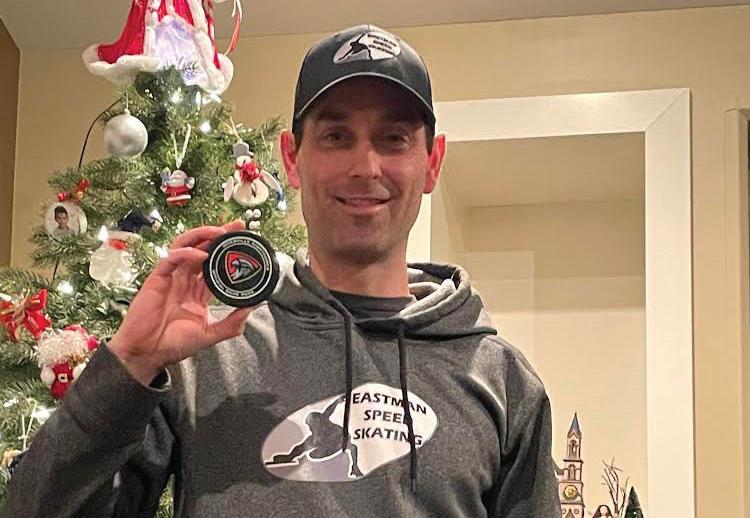 By Jennifer Lavin m jlavin@nivervillecitizen.com
By Jennifer Lavin m jlavin@nivervillecitizen.com
Colin Tétrault of Ste. Agathe has spent much of his life in a pair of skates, and once again his talent on the ice has rewarded him—this time with $5,000 cash.
Tétrault, who is the first to win the contest, was at the Niverville Nighthawks game with his family on December 9 to promote the Eastman Speed Skating Club during the first intermission.
In the second intermission, he was picked to try his hand at the Hub Shoot to Win
contest.
The contest gives the chosen person one chance to shoot a puck from the far blue line into a hole just big enough for a puck to enter.
“I honestly just wanted to hit the net,” Tétrault says. “As a former junior hockey player, I didn’t want to miss the net, but I did feel relaxed. After I shot the puck, I knew it looked good. But I really knew it went in when the crowd erupted. I was somewhat in shock, but I just felt like I should do a celebration, so I went for the kayak.”
What’s a kayak? It means
he got down on the ice and pretended to paddle!
Tétrault says he felt like a celebrity after he won, as he was getting high fives from everyone around him.
“I think my daughter almost lost her voice from screaming loudly,” he says. “I honestly didn’t think of the money until after, as I was so focused on doing well with the shot. It was such a terrific experience, and it seems like the arena became more lively for a great third period. The next day, I was helping at a speed skating meet in Portage la Prairie but I was also busy
answering a barrage of messages from my friends during my breaks. Overall, it’s a surreal experience. Everyone asks me what I will do with the money. It’s nothing exciting; it will help pay for my children’s activities.”

Tétrault played junior A hockey with the Southeast Blades, now known as the Steinbach Pistons, from 2000 to 2003.He then went on to play senior hockey with the La Broquerie Habs for many years as well.
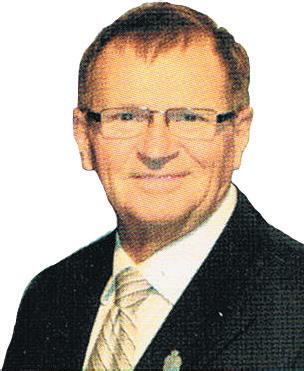
He says that he now just plays once a week with his friends for fun.

Volleyball season has winded down for the year, but our local athletes have a lot to be proud of.
Niverville High School ran five volleyball teams this fall: two Junior Varsity (JV) girls teams, one JV boys team, one Varsity girls team, and one Varsity boys team.
The JV girls Red team was created as a developmental team and was coached by high school students.
The JV girls Black team was the competition squad, and they had the distinction of winning the Zone championship. They went on to compete in the AAA Provincial championship in Altona, losing out in the quarterfinals.
“The boys JV and Varsity teams were both very competitive, young teams,” says Ron Limpright, one of the coaches of the Varsity boys squad.
Unfortunately, both of those teams lost in their Zone finals, meaning they didn’t qualify for Provincials.
However, Marcus Zeilstra from the Varsity squad was named a graduating all-star.
Limpright explains that the Varsity girls chose to move up a division this year so they could play at the ultra-competitive AAAA level. Even at that new and more advanced level, the girls performed well, winning both their home tournament and the Calvin Christian School tournament.
They went into their Provincials ranked ninth. Ultimately, they were eliminated in the quarterfinals in a very
close match, losing 15–12 in the fifth set.
Aysia Richards and Mala Thiessen were named graduating all-stars.
The coaches at Niverville High School were also thrilled to be able to use their large space to host tournaments this year for the first time. They welcomed 36 JV teams in September and 32 Varsity teams in October.
The École et Collège régional Gabrielle-Roy (CRGR) Les Roys compete at the A/AA level and both the JV girls and boys teams made it to Provincials. The JV girls were bested in the quarterfinals, but the JV boys were able to take it all the way and won the A/ AA championship for the second year in a row. During the tournament, they won all six of their matches.
Four local boys received special honours at Provincials. David Lemoine of Ste. Agathe was named the tournament MVP, and Alec Ouimet and Martin DeMoissac, also from Ste. Agathe, and Jacob Boisjoilie of St. Adolphe were named all-stars.
The CRGR Varsity boys made it to Provincials as well but lost to Landmark in the finals. Max Vermette of St. Adolphe was named the tournament MVP and Noah Ouimet of Ste. Agathe was an all-star.
Of special note is Ste. Agathe resident Benjamin Doan, who plays for the Glenlawn Lions in Winnipeg. The Lions won the AAAA JV Boys championship. To make that achievement even sweeter, Doan was named Provincials MVP.
EMAIL: chamber@niverville.com PHONE: 204-388-6140



President: Amanda Wiens | Vice-President: Elvin Krahn
Executive Director: Bre-Ann Boulet | Treasurer: Nicholas Bergmann
Executive Member: Karen Albaugh | Members: Bryan Trottier, Ben Dueck, Scott Wallace

www.niverville.com
The Niverville Chamber of Commerce has been part of Niverville and surrounding area since 1954. Over that time the chamber has played a signi cant role in developing the community.
Members of our chamber receive a number of bene ts:
• the opportunity to have a voice in issues that matter to business through the chamber’s representation to the Town of Niverville and provincial and federal governments through the chamber’s membership in the Manitoba Chambers of Commerce
• the opportunity to meet other businesspeople in the area;






• the opportunity to promote their business;

• the opportunity to make connections that will enhance their business; and


• the opportunity for continual learning.
The Niverville Chamber of Commerce is a member of the Manitoba Chambers of Commerce. This allows our members to:






• access a nity programs o ered by the Manitoba Chambers;





• attend Manitoba Chambers events at member pricing; and









• be listed in the Manitoba Chambers of Commerce annual directory and on its website.
Of particular bene t is the Chambers of Commerce Group Insurance Plan, a pooled insurance plan, available only to members of chambers of commerce. This plan is particularly suited to small businesses and solopreneurs. Further details are available in this folder.
If you have questions, please contact us at 204-388-6140 or email chamber@niverville.com














On December 3, the members of the local Eastman Speed Skating Club (ESSC) attended the Melville Short Track Abilities Meet 2022 in Saskatchewan and pulled off some amazing performances.
Since relocating their base from Steinbach to Niverville in 2020, the ESSC has grown in numbers and was able to send six members to the Melville meet. Another eight skaters from Manitoba also attended the meet of 79 competitors.


The ESSC members performed exceptionally well.
Greyson and Kaylee Siemens, siblings from St-Jean-Baptiste, both had personal best times at the competition.
Sisters Kalia and Mia Tétrault from Ste. Agathe also won the








overall gold medal in their categories (six- to eight-year-old female and 11- to 14-year-old female respectively).
Mackenna Reimer from Niverville won the silver medal in the nine- to ten-year-old female category, and Willa Dowse won the silver medal in the 11- to 14-yearold female category.


Corinne Reimer, Mackenna’s mother, has been impressed with the sport of speed skating and how it has helped shape her daughter.
“It has been really fun watching Mackenna find a sport that she really enjoys,” says Corinne. “The speed skating community in Manitoba has been very encouraging, and she is growing each meet. We have been very impressed with all of the great coaches that she has had over the past year and a half.”

Mackenna herself says that she


especially enjoys speed skating because she gets the opportunity to race against her personal best with each and every race.
“At the Melville meet, I got to meet a lot of new people from Saskatchewan and set two personal bests and won a silver medal,” says Mackenna. “And when I fell down, I got back up and finished the race. It felt really good when everyone cheered for me.”
Mia Tétrault of Ste. Agathe also sees speed skating as offering a tremendous opportunity.

“It’s such a great experience when I get to travel to a different province to compete against a variety of new skaters,” she says. “I get to meet new people and I get to compete with my friends from our club as wel.”
Willa Dowse agrees with Tétrault. “Melville was a super fun competition/experience,” Dowse
















remarks. “It was great to skate against new people and I am really excited for how well my team did!”
The Eastman Speed Skating Club is clearly doing something right as they seem to be producing athletes of both skill and good character.
Despite the high level of competition, however, the skaters make a point of emphasizing that there’s still lots of room for fun.
“[Mackenna] says that I should also tell you that it felt great to kick some Saskatchewan butt,” Corinne Reimer says with a laugh. “She’s a true Manitoban!”










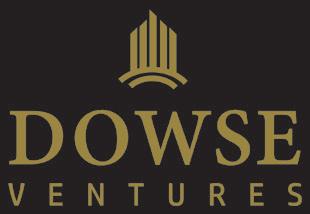

If you’re interested in learning more about the sport or trying speed skating, contact Eastman Speed Skating: eastmanspeed skating@gmail.com.








































